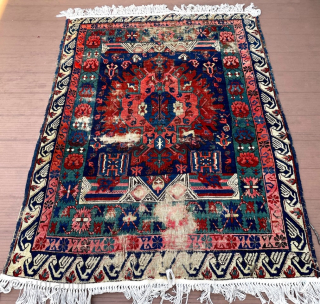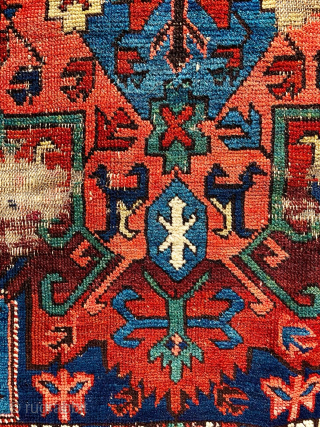Back
Antique Kuba Zeichor rug, could date well back in the 19th c. Size is 64 in. x 47 in. (163 cm x 120 cm) Some of its features are typical Zeichor, and others might be unique. The field is almost wholly occupied by a single large floral palmette medallion that encloses a more geometric one. The outer “wave” border is typical of Zeichor, but here the floral elements that extend into the white spaces between waves are more elaborate and colorful than usual. The middle border with coral ground has a scrolling motif common in Zeichor rugs, but the colors are atypical here. The inner, green-ground border was begun with a variant of the “crab” design across the lower end and beginning up the sides, and then changes to the “cabbage rose” or “gul farangi” motif—then, across the top , this border returns to the crab motif. The rectangular panels with geometric designs across both ends of the field (almost like extra end borders) are unusual, maybe unique to this rug. Some small motifs have what look like the “bird head” details often seen in Turkmen weavings (remind me of Turkmen “tauk nosca” motifs.) The rug’s condition should be evident from the images. Some areas have wear is to the foundation, but the foundation is mostly intact—some small areas near the bottom end where wefts are worn through, but only a few broken warps. a small old reweave in the upper border (see last two images). Otherwise mostly low to medium pile, with some areas of nice pile mainly in border areas. The handle is very soft and floppy---unusually so for a Kuba rug. Both ends have sewn-on commercial machine-made “fringes”---a previous owner obviously thought that a proper rug must have fringes at the end, but used this rug too long on the floor.
price:
SOLD--MANY THANKS
- Home
- Antique Rugs by Region
- Category
- Profiles
- Post Items Free
- Albums
- Benaki Museum of Islamic Art
- Budapest: Ottoman Carpets
- Gulbenkian Museum
- Islamic Carpets. Brooklyn
- Islamic Textiles. Brooklyn
- Konya Museum: Rugs
- MKG, Hamburg
- MMA: Caucasian Carpets
- MMA: Mamluk Carpets
- MMA: Mughal Indian Carpets
- MMA: Ottoman Carpets
- MMA: Safavid Persian Carpets
- MMA: Turkmen Rugs
- McCoy Jones Kilims
- Ottoman textiles. Met
- Philadelphia Museum
- Rugs and Carpets: Berlin
- Seljuqs at the Met
- TIEM, Istanbul: Carpets
- V&A: Classical Carpets
- Vakiflar Carpets: Istanbul
- Baluch Rugs: Indianapolis
- Gallery Exhibitions
- Jaf an Exhibition
- Alberto Levi Gallery
- Andean Textile
- Christie's London: 2016
- Francesca Galloway
- HALI at 40
- ICOC Washington, DC 2018
- Jajims of the Shahsavan
- London Islamic Week April, 2018
- Mongolian Felts
- Navajo Rugs: JB Moore
- Persian Piled Weavings
- SF Tribal & Textile Art Show 2020
- SF Tribal 2019
- Sotheby's: C. Alexander
- Turkish Prayer Rugs
- Turkmen Main Carpets ICOC 2007















